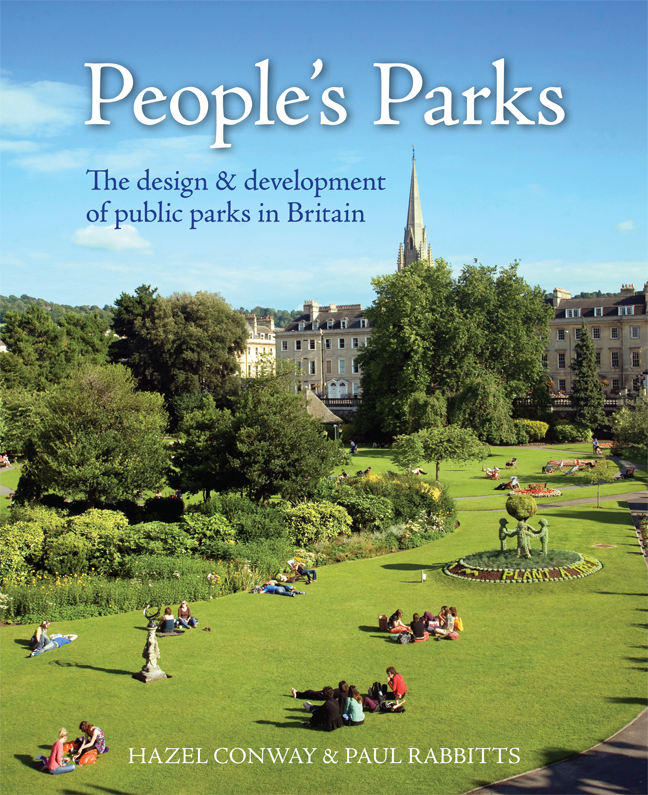Book contents
- Frontmatter
- Dedication
- Contents
- Miscellaneous Frontmatter
- Preface
- Acknowledgements
- Foreword
- A Word from Parks Professionals, Politicians and Parks Organisations
- Introduction: Dr Hazel Conway (1991)
- 1 Public Parks and Municipal Parks
- 2 The Need for Parks
- 3 Pioneering Parks Development
- 4 The Park Movement
- 5 Design and Designers
- 6 Lodges, Bandstands and the Cultivation of Virtue
- 7 Local Pride and Patriotism
- 8 Planting and Park Maintenance
- 9 Permitted Pastimes
- 10 Recreation Grounds, Parks and the Urban Environment
- 11 Public Parks, 1885–1914
- 12 Later Municipal Park Designers
- 13 Garden Cities and the New Towns Movement
- 14 Sport, Physical Activity and Recreation in Public Parks in the Inter-war Years
- 15 Parks Management – a Changing Perspective
- 16 Decline, Revival and Renewal – the Role of Parks into 21st-century Britain
- Appendix 1 Summary of main legislation promoting early park development
- Appendix 2 Chronology of main municipal and public park developments between 1800 and 1885
- Notes
- Bibliography
- Subscription List
- Index
6 - Lodges, Bandstands and the Cultivation of Virtue
Published online by Cambridge University Press: 22 February 2024
- Frontmatter
- Dedication
- Contents
- Miscellaneous Frontmatter
- Preface
- Acknowledgements
- Foreword
- A Word from Parks Professionals, Politicians and Parks Organisations
- Introduction: Dr Hazel Conway (1991)
- 1 Public Parks and Municipal Parks
- 2 The Need for Parks
- 3 Pioneering Parks Development
- 4 The Park Movement
- 5 Design and Designers
- 6 Lodges, Bandstands and the Cultivation of Virtue
- 7 Local Pride and Patriotism
- 8 Planting and Park Maintenance
- 9 Permitted Pastimes
- 10 Recreation Grounds, Parks and the Urban Environment
- 11 Public Parks, 1885–1914
- 12 Later Municipal Park Designers
- 13 Garden Cities and the New Towns Movement
- 14 Sport, Physical Activity and Recreation in Public Parks in the Inter-war Years
- 15 Parks Management – a Changing Perspective
- 16 Decline, Revival and Renewal – the Role of Parks into 21st-century Britain
- Appendix 1 Summary of main legislation promoting early park development
- Appendix 2 Chronology of main municipal and public park developments between 1800 and 1885
- Notes
- Bibliography
- Subscription List
- Index
Summary
The lodge by the main entrance gates, with the park regulations displayed prominently nearby, is often the first building to greet the park visitor. This was the home of the superintendent responsible for seeing that order was kept in the park and for opening and closing the main gates, morning and evening. The importance of the role of the park superintendent could be emphasised by the scale of the lodge and this in turn reinforced the significance of the park as a place apart. Pennethorne clearly recognised this when he recommended that the main lodge at Victoria Park, erected in 1847, ought ‘to contain more conveniences and to be more important in appearance than the other lodges’. Elizabethan in character, and built of brick with stone dressings, this was a substantial and imposing building. A decade later, three more lodges were erected at the other park entrances, but even the largest of these was less imposing than the main lodge.
Park buildings fall into three main categories: those needed for maintenance, those intended for the park users, and commemorative buildings and structures, which will be the subject of Chapter 7. The prototype of most park buildings lay elsewhere, for lodges, shelters, boathouses and pagodas had been a feature of the private parks of the 18th century and earlier, while palm houses and conservatories had developed in the early decades of the 19th century. The one building that became so closely identified with public parks that it came almost to signify them, was the bandstand, although it too was built elsewhere. Refreshment rooms, toilets, drinking fountains and shelters made it practicable to spend considerable time in the parks, which would otherwise have been impossible, but the need for such facilities had not always been recognised. C H J Smith, the Scottish theorist and practitioner of landscape gardening, who was writing on public parks in 1852, was evidently not concerned with the comfort of the park users, nor with the question of bad weather. He thought that a superintendent's house, cottages for the gate-keepers and a greenhouse for the propagation and protection of plants would suffice.
Siting buildings
In the early stages of the park movement, the design and siting of park buildings were the subject of two virtually opposing principles.
- Type
- Chapter
- Information
- People's ParksThe design & development of public parks in Britain, pp. 81 - 116Publisher: Boydell & BrewerPrint publication year: 2023

